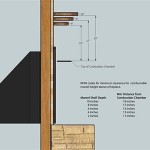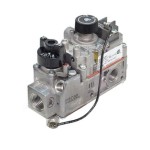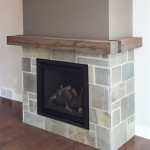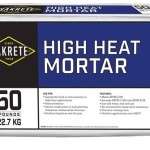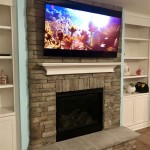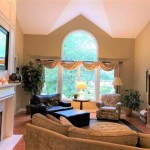Painting Brick Fireplace White: A Transformative Before and After
The decision to paint a brick fireplace white is a significant one, often resulting in a dramatic transformation of a living space. The inherent character of brick, with its rustic textures and earthy tones, can be perceived as either a design asset or a visual liability, depending on evolving aesthetic preferences and the overall design of the room. Painting brick white offers a way to modernize a space, lighten a dark area, or simply integrate the fireplace more seamlessly into a contemporary interior design scheme. This article will explore the process of painting a brick fireplace white, highlighting the key steps involved, the materials required, and the significant before and after visual impact this project can achieve.
Assessing the Brick and Preparing the Surface
Before commencing the painting process, a thorough assessment of the brick surface is crucial. The condition of the brick will directly impact the success and longevity of the paint job. Cracks, loose mortar, and efflorescence (a white, powdery deposit) must be addressed before any primer or paint is applied. Neglecting these issues can lead to paint failure, resulting in peeling, chipping, and an overall aesthetically unappealing outcome.
The first step is to clean the brick thoroughly. A wire brush can be used to remove loose debris, dirt, and any flaking paint from previous applications. A solution of trisodium phosphate (TSP) and water, following the manufacturer's instructions, is effective for removing grease, grime, and soot. It is essential to wear appropriate protective gear, including gloves and eye protection, when working with TSP. After scrubbing the brick with the TSP solution, rinse it thoroughly with clean water to remove any residue. Allow the brick to dry completely, which may take several days, depending on the humidity and ventilation.
Once the brick is clean and dry, inspect it for cracks and loose mortar. Small cracks can be filled with a masonry crack filler, while larger cracks and areas of missing mortar require repointing. Repointing involves removing the old, deteriorated mortar and replacing it with new mortar. This process requires some skill and patience to ensure a proper bond and a seamless finish. Allow the crack filler or new mortar to cure completely according to the manufacturer's instructions before proceeding.
Efflorescence, a common problem with brick fireplaces, is caused by water-soluble salts migrating to the surface of the brick and crystallizing. It must be removed before painting, as it can interfere with paint adhesion. A stiff brush and a solution of muriatic acid diluted with water, following the manufacturer's instructions and safety precautions, can be used to remove efflorescence. Be sure to wear appropriate protective gear, including gloves, eye protection, and a respirator, when working with muriatic acid. Rinse the brick thoroughly with clean water after applying the acid solution and allow it to dry completely.
Finally, tape off any areas that need protection, such as the surrounding wall, the firebox opening, or any decorative elements. This will ensure clean lines and prevent paint from getting where it is not wanted.
Selecting the Right Primer and Paint
Choosing the right primer and paint is critical for achieving a durable and aesthetically pleasing finish on a brick fireplace. Not all primers and paints are created equal, and selecting products specifically designed for masonry surfaces is essential.
A high-quality masonry primer is the foundation of a successful paint job. The primer seals the porous surface of the brick, preventing the paint from being absorbed and ensuring proper adhesion. An alkali-resistant primer is particularly important for brick, as it helps to neutralize the alkalinity of the masonry and prevent the paint from deteriorating over time. Look for a primer that is specifically labeled for use on masonry surfaces and that is designed to resist efflorescence. Apply the primer evenly, using a brush, roller, or sprayer, depending on the size and texture of the brick. Allow the primer to dry completely according to the manufacturer's instructions before applying the paint.
For the paint, a high-quality latex paint in a matte or eggshell finish is generally recommended. Matte finishes are less reflective and tend to hide imperfections better, while eggshell finishes are slightly more durable and easier to clean. Avoid using glossy paints on brick fireplaces, as they can highlight imperfections and create an unnatural look. Choose a paint that is specifically formulated for interior use and that is resistant to heat and moisture. A paint with a built-in mildewcide is also a good option, especially for fireplaces that are located in damp environments. Apply two coats of paint, allowing each coat to dry completely before applying the next. Use a brush to get into the mortar joints and textured areas of the brick, and a roller for the larger, flat surfaces.
The specific shade of white is also a crucial consideration. There is a wide spectrum of white paint colors, ranging from cool whites with blue undertones to warm whites with yellow or cream undertones. Consider the existing color palette of the room and choose a white that complements the other elements in the space. Sample several different shades of white on a small, inconspicuous area of the brick before making a final decision.
The Painting Process and Achieving a Professional Finish
The actual painting process requires patience and attention to detail. Following a methodical approach is essential for achieving a professional-looking finish and avoiding common pitfalls.
Start by applying the primer to the entire brick surface. Use a brush to work the primer into the mortar joints and textured areas of the brick. A small roller can be used to apply the primer to the larger, flat surfaces. Ensure that the primer is applied evenly and that all areas of the brick are covered. Allow the primer to dry completely according to the manufacturer's instructions. This is a critical step, as the primer provides the foundation for the paint and ensures proper adhesion.
Once the primer is dry, begin applying the first coat of paint. Use the same technique as with the primer, working the paint into the mortar joints and textured areas with a brush, and using a roller for the larger, flat surfaces. Apply the paint evenly and avoid applying it too thickly, as this can lead to drips and runs. Allow the first coat of paint to dry completely before applying the second coat. This is important for achieving a smooth, even finish.
After the first coat of paint has dried completely, inspect the brick for any imperfections, such as drips, runs, or areas where the paint is thin. Use a fine-grit sandpaper to gently sand down any imperfections and smooth out the surface. Wipe away any dust with a damp cloth before applying the second coat of paint.
Apply the second coat of paint using the same technique as with the first coat. This coat will provide additional coverage and ensure a rich, even color. Allow the second coat of paint to dry completely before removing the painter's tape. Use a sharp utility knife to score along the edge of the tape before removing it to prevent the paint from peeling away with the tape.
Once the paint is completely dry, inspect the fireplace for any touch-ups that may be needed. Use a small brush to touch up any areas where the paint is thin or where there are imperfections. Clean up any spills or splatters immediately with a damp cloth. Allow the touch-up paint to dry completely before using the fireplace.
The transformation from a dated, dark brick fireplace to a bright, white focal point can be dramatic. The white paint instantly lightens the space, creating a more modern and inviting atmosphere. The fireplace becomes a statement piece, complementing the overall design of the room and adding a touch of elegance. The before and after photos often speak for themselves, showcasing the power of paint to completely transform a space.

How To Paint Brick White Before And After Diy Fireplace Gina Marie

Painting Brick Fireplace White A Renovation Story

How To Paint A Brick Fireplace
:max_bytes(150000):strip_icc()/before-and-after-painted-brick-fireplace-makeovers-7566363-7d056828747b43e7a58fa9f724c2cb26.jpg?strip=all)
15 Before And After Painted Brick Fireplace Makeovers

Whitewash Brick Fireplace Before And After White Wash Makeover

How To Paint Your Fireplace Brick Surround

How To Paint A Brick Fireplace Sarah Joy White Makeover Home

Paint Your Brick Fireplace Sutherlands Blog

How To Paint A Brick Fireplace Diy From Lovely Indeed

How To Paint A Brick Fireplace
Related Posts


